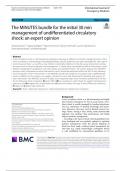Summary
Summary circulatory shock:
- Course
- Institution
ghly time-sensitive emergency [1]. For its acute nature, circu- latory shock is usually managed by frontline physicians, who are, sometimes, of limited knowledge and experi- ence. Moreover, they may work in limited resource set- tings. Hence, having a clear, timely, easily memorizable appr...
[Show more]



